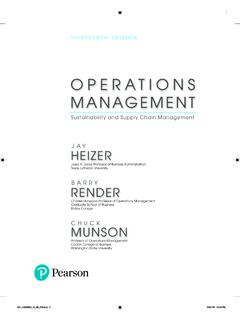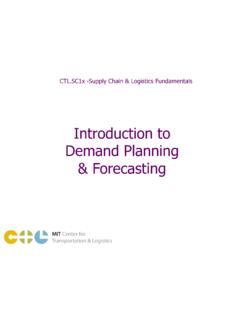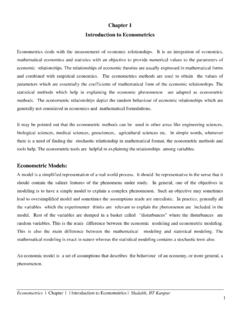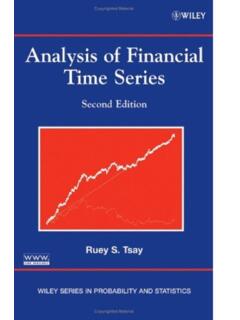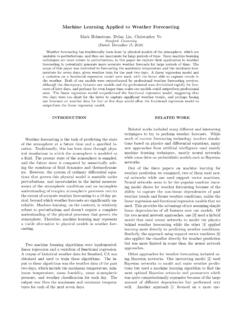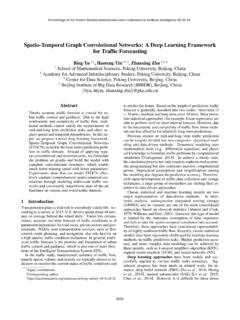Transcription of Business Forecasting: Practical Problems and Solutions
1 XiContentsForeword xvPreface xixChapter 1 Fundamental Considerations in Business forecasting Getting Real about Uncertainty (Paul Goodwin) What Demand Planners Can Learn from the Stock Market (Charles K. Re Corr) Toward a More Precise Definition of Forecastability (John Boylan) Forecastability: A New Method (Sean Schubert) Forecast Errors and Their Avoidability (Steve Morlidge) The Perils of Benchmarking (Michael Gilliland) Can We Obtain Valid Benchmarks from Published Surveys of Forecast Accuracy? (Stephan Kolassa) Defining Demand for Demand forecasting (Michael Gilliland) Using forecasting to Steer the Business : Six Principles (Steve Morlidge) The Beauty of forecasting (David Orrell) 76 Chapter 2 Methods of Statistical forecasting Confessions of a Pragmatic Forecaster (Chris Chatfield) New Evidence on the Value of Combining Forecasts (Paul Goodwin) How to Forecast Data Containing Outliers (Eric Stellwagen) Selecting Your Statistical forecasting Level (Eric Stellwagen) When Is a Flat-line Forecast Appropriate?
2 (Eric Stellwagen) forecasting by Time Compression (Udo Sglavo) Data Mining for forecasting : An Introduction (Chip Wells and Tim Rey) Process and Methods for Data Mining for forecasting (Chip Wells and Tim Rey) Worst-Case Scenarios in forecasting : How Bad Can Things Get? (Roy Batchelor) Good Patterns, Bad Patterns (Roy Batchelor) 135 From Business forecasting : Practical Problems and Solutions . Full book available for purchase C o n t e n t sChapter 3 forecasting Performance Evaluation and Reporting Dos and Don ts of Forecast Accuracy Measurement: A Tutorial (Len Tashman) How to Track Forecast Accuracy to Guide Forecast Process Improvement (Jim Hoover) A Softer Approach to the Measurement of Forecast Accuracy (John Boylan) Measuring Forecast Accuracy (Rob Hyndman) Should We Define Forecast Error as e = F A or e = A F?
3 (Kesten Green and Len Tashman) Percentage Error: What Denominator? (Kesten Green and Len Tashman) Percentage Errors Can Ruin Your Day (Stephan Kolassa and Roland Martin) Another Look at Forecast-Accuracy Metrics for Intermittent Demand (Rob Hyndman) Advantages of the MAD/Mean Ratio over the MAPE (Stephan Kolassa and Wolfgang Sch tz) Use Scaled Errors Instead of Percentage Errors in Forecast Evaluations (Lauge Valentin) An Expanded Prediction-Realization Diagram for Assessing Forecast Errors (Roy Pearson) Forecast Error Measures: Critical Review and Practical Recommendations (Andrey Davydenko and Robert Fildes) Measuring the Quality of Intermittent Demand Forecasts: It s Worse than We ve Thought! (Steve Morlidge) Managing Forecasts by Exception (Eric Stellwagen) Using Process Behavior Charts to Improve forecasting and Decision-Making (Martin Joseph and Alec Finney) Can Your Forecast Beat the Na ve Forecast?
4 (Shaun Snapp) 276 Chapter 4 Process and Politics of Business forecasting FVA: A Reality Check on forecasting Practices (Michael Gilliland) Where Should the forecasting Function Reside (Larry Lapide) Setting Performance Objectives (Michael Gilliland) Using Relative Error Metrics to Improve Forecast Quality in the Supply Chain (Steve Morlidge) Why Should I Trust Your Forecasts? (M. Sinan G n l, Dilek nkal, and Paul Goodwin) 309C o n t e n t s High on Complexity, Low on Evidence: Are Advanced forecasting Methods Always as Good as They Seem? (Paul Goodwin) Should the forecasting Process Eliminate Face-to-Face Meetings? (J. Scott Armstrong) The Impact of Sales Forecast Game Playing on Supply Chains (John Mello) Role of the Sales Force in forecasting (Michael Gilliland) Good and Bad Judgment in forecasting : Lessons from Four Companies (Robert Fildes and Paul Goodwin) Worst Practices in New Product forecasting (Michael Gilliland) Sales and Operations Planning in the Retail Industry (Jack Harwell) Sales and Operations Planning: Where Is It Going?
5 (Tom Wallace) 372 About the Editors 381 Index 383 From Business forecasting : Practical Problems and Solutions , by Mike Gilliland, Len Tashman, and Udo Sglavo. Copyright 2015, SAS Institute Inc., Cary, North Carolina, USA. ALL RIGHTS h a p t e r1 Fundamental Considerations in Business ForecastingFrom Business forecasting : Practical Problems and Solutions . Full book available for purchase in Business forecasting , such as increasing accuracy and reduc-ing bias, are best met through effective management of the forecasting process. Effective management, we believe, requires an understanding of the realities, limitations, and principles fundamental to the process. When management lacks a grasp of basic concepts like randomness, variation, uncer-tainty, and forecastability, the organization is apt to squander time and resources on expensive and unsuccessful fixes: There are few other endeavors where so much money has been spent, with so little chapter provides general guidance on important considerations in the practice of Business forecasting .
6 The authors deal with: Recognition of uncertainty and the need for probabilistic forecasts The essential elements of a useful forecast Measurement of forecastability and bounds of forecast accuracy Establishing appropriate benchmarks of forecast accuracy The importance of precisely defining demand when making demand forecasts Guidelines for improving forecast accuracy and managing the forecasting function Although we were unable to secure rights to include it in this book, Makri-dakis and Taleb s Living in a World of Low Levels of Predictability from the International Journal of forecasting is an important piece worth mentioning in any consideration of fundamental Makridakis is very well recognized as lead author of the standard forecasting text, forecasting : Methods and Applications, and of the M- series fore- casting competitions.
7 Through his books, Fooled by Randomness and The Black Swan, Nassim Nicholas Taleb has drawn popular attention to the issue of unforecastability of complex systems, and made black swan a part of the vernacular. Their article, published in the International Journal of forecasting (2009), speaks to the sometimes disastrous consequences of our illusion of control believing that accurate forecasting is referring to the (mostly unforeseen) global financial collapse of 2008 as a prime example of the serious limits of predictability, this brief and nontech-nical article summarizes the empirical findings for why accurate forecasting is often not possible, and provides several Practical approaches for dealing with this uncertainty. For example, you can t predict when your house is going to burn down.
8 But you can still manage under the uncertainty by buying fire u n d a m e n t a l C o n s i d e r a t i o n s i n B u s i n e s s F o r eCas t i n g 3So why are the editors of a forecasting book so adamant about mentioning an article telling us the world is largely unforecastable? Because Makridakis and Taleb are correct. We should not have high expectations for forecast accuracy, and we should not expend heroic efforts trying to achieve unrealistic levels of , by accepting the reality that forecast accuracy is ultimately limited by the nature of what we are trying to forecast, we can instead focus on the effi-ciency of our forecasting processes, and seek alternative (nonforecasting) solu-tions to our underlying Business Problems . The method of forecast value added (FVA) analysis (discussed in several articles in Chapter 4) can be used to identify and eliminate forecasting process activities that do not improve the forecast (or may even be making it worse).
9 And in many situations, large-scale automated software can now deliver forecasts about as accurate and unbiased as anyone can reasonably expect. Plus, automated software can do this at relatively low cost, without elaborate processes or significant management Business forecasting , the objective should be:To generate forecasts as accurate and unbiased as can reasonably be expected and to do this as efficiently as goal is not 100% accurate forecasts that is wildly impossible. The goal is to try to get your forecast in the ballpark, good enough to help you make better decisions. You can then plan and manage your organization effec-tively, and not squander resources doing GettinG Real aBout unCeRtainty*Paul GoodwinBusiness forecasters tend to rely on the familiar point forecast a single number representing the best estimate of the result.
10 But point forecasts provide no indication of the uncertainty in the number, and uncertainty is an important consideration in decision making. For example, a forecast of 100 10 units may lead to a much different planning decision than a forecast of 100 100 this opening article, Paul Goodwin explores the types of probabilistic forecasts, the academic research behind them, and the numerical and graphical displays afforded through prediction intervals, fan charts, and probability density charts. Providing uncertainty information, he explains, can result in better decisions; however, probabilistic forecasts may be subject to misinterpretation and may be difficult to sell to managers. There is also an unfortunate tendency we have to seriously underestimate the uncertainty we face and hence overstate our forecast s article provides Practical recommendations and additional sources of guidance on how to estimate and convey the uncertainty in forecasts.










